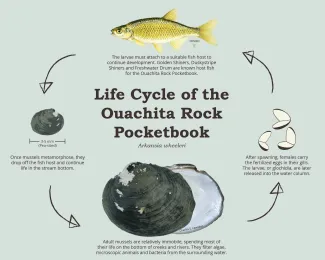Life on the bottom of a river is no picnic, especially for the mostly stationary filter-feeding mollusks. Not only do these living rocks have to contend with changes in water flow and quality, they also face pollution, siltation and man-made lakes that limit genetic flow.
These threats and more have led to the staggering decline of many freshwater mussels, including the Ouachita rock pocketbook, Arkansia wheeleri. Found only in the Ouachita Mountain streams of Oklahoma and Arkansas, this mussel has been reduced to fewer than 2,000 individuals.

Combating these challenges and reversing the decline of this federally endangered mussel requires teamwork and creative thinking. In 2011, the Oklahoma Department of Wildlife Conservation entered a partnership with the U.S. Fish and Wildlife Service, the Arkansas Game and Fish Commission and Missouri State University to develop a plan. That plan is to collect wild mussels, raise the developing larvae in a laboratory and later release the juvenile mussels back into the river.
The plan was put into action in December 2012 when a group of U.S. Fish and Wildlife biologists gathered on the banks of the Little River in southeastern Oklahoma to don dry suits and scuba gear. Armed with large baskets, they entered the 50-degree water and sank 5 feet below the surface to search for groups of mussels along the graveled river bottom.
Since then, biologists have made return trips each winter when river conditions allow, surveying only when the river is low and the water is clear.
Their target, the endangered Ouachita rock pocketbook, often congregates with more than 30 species of mussels in large "mussel beds." Since Ouachita rock pocketbooks average less than 1% of an individual mussel bed that can cover more than three acres, the effort is more like searching for a needle in a haystack. Not only are these mussels rare, but they also look like a number of other species.
To find an Ouachita Rock Pocketbook, biologists must carefully sort through each mussel in the bed by bringing a basket full of mussels to the river bank, identifying the species of each mussel, and returning them to their previous location on the bottom of the river. Any Ouachita Rock Pocketbook found is examined for larvae, and the gravid females are collected for the project.

Should any female Ouachita rock pocketbooks be collected during this winter's survey, they will be transported to a captive-rearing facility at Missouri State University in Springfield, Mo. There, Dr. Chris Barnhart, a professor of biology, will collect any larvae held within the female mussel's gills and return those adults to the very mussel bed in the Little River from where they were taken. The larval mussels normally become pinhead-size parasites on fish gills, where they metamorphose from the larval to the juvenile stage. Only certain kinds of fish will work for this step, and even the best hosts don't produce many juvenile mussels. Therefore, the MSU group is using a 'test tube' approach to bypass the fish and produce large numbers of juvenile mussels in the lab.
Then the juvenile mussels must be cared for and grown larger to improve their chances of survival when released. This will take place in two steps, first in the laboratory to raise them to the size of a pea, and later in protective cages staked in the Little River. These cages will be in place for one to two years to limit predation and improve mussel survivorship. During this time, the mussels will grow to the size of a penny, at which point they will be set free. Although river conditions have postponed the survey and collection portion of the plan several times, larvae were obtained from one female Arkansia last year, and juveniles were produced both from fish hosts and using the 'test tube' approach. A closely related mussel species is also being tested to improve culture methods.